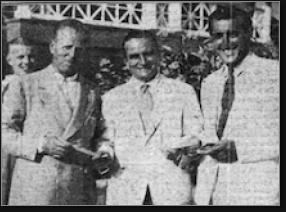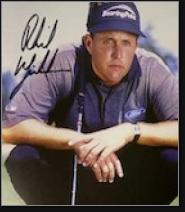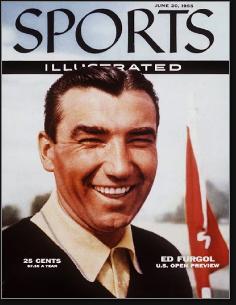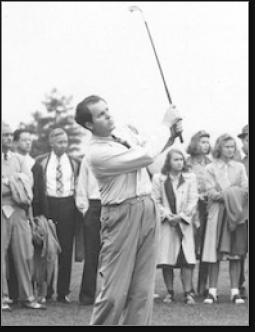It Happened In Jersey: Golf
BIG DEAL
 During the 1930s, the New Jersey Open brought together some of the finest golfers in the country, as many were stationed around the Garden State as club pros. In 1937, at the Shackamaxon Country Club in Westfield, two of the best—Vic Ghezzi of the Deal Country Club and Craig Wood of the Rumson Country Club—finished tied at 278 after four rounds. Ghezzi appeared to have a solid lead, but Wood shot a 65 to catch him on Saturday, the final day, extinguishing an 8-stroke deficit.Wood actually could have shot a 277, but a birdie putt on 17 rimmed out. Ghezzi had lost a playoff in the Open to Johnny Farrell the year before. This time, Ghezzi prevailed in the ensuing 18-hole playoff, 69 to 70. Wood was better off the tees and on the fairways, but Ghezzi was better on the greens. First-place prize money was $400, while second-place was good for $175. In 1941, Ghezzi (right) and Wood (left) enjoyed especially fine seasons on the pro tour when Wood won the Masters and US Open, and Ghezzi captured the PGA Championship. During the 1930s, the New Jersey Open brought together some of the finest golfers in the country, as many were stationed around the Garden State as club pros. In 1937, at the Shackamaxon Country Club in Westfield, two of the best—Vic Ghezzi of the Deal Country Club and Craig Wood of the Rumson Country Club—finished tied at 278 after four rounds. Ghezzi appeared to have a solid lead, but Wood shot a 65 to catch him on Saturday, the final day, extinguishing an 8-stroke deficit.Wood actually could have shot a 277, but a birdie putt on 17 rimmed out. Ghezzi had lost a playoff in the Open to Johnny Farrell the year before. This time, Ghezzi prevailed in the ensuing 18-hole playoff, 69 to 70. Wood was better off the tees and on the fairways, but Ghezzi was better on the greens. First-place prize money was $400, while second-place was good for $175. In 1941, Ghezzi (right) and Wood (left) enjoyed especially fine seasons on the pro tour when Wood won the Masters and US Open, and Ghezzi captured the PGA Championship.
 MAGNIFICENT FLOP MAGNIFICENT FLOP
The 2006 PGA Championship at the Baltusrol Golf Club in Springfield featured no fewer than 7 different past winners in the field, including Tiger Woods, Davis Love and Steve Elkington. As the final round was postponed in the early evening because of rain, all three were in the hunt, with Woods in the clubhouse as tournament leader following a solid 68. The next day, Monday, Phil Mickelson—who had either been in the lead or tied after each of the first three rounds—was tied with Elkington and Thomas Bjorn as they played the 72nd hole. Mickelson faced a difficult 50-foot chip from the deep grass. He lifted a high, arcing pitch that settled within two feet of the cup—a perfect “flop” shot. Elkington and Bjorn missed their birdie putts and Mickelson tapped his ball in for the win. Love and Woods finished tied for 4th, two strokes back.

SIDEWAYS
One of the most imaginative shots in history took place at Baltusrol on the final hole of the 1954 US Open. Ed Furgol was leading Gene Littler and needed a par 5 to win. Furgol pulled his tee shot into the rough and had no choice but to chip the ball back onto the fairway. Or did he?
The 18th fairways on Baltusrol's Upper and Lower Courses run parallel. Furgol saw a lot of green available on the Upper Course, so he decided to blast an 8 iron toward the "other" 18th green. From there, he lifted a 7-iron back onto the Lower Course. Furgol chipped the ball onto the green and holed his putt to defeat Littler by a stroke.
KEEPING UP WITH THE JONESES
Prior to the 1954 Open, course designer Robert Trent Jones had been brought in to revamp Baltusrol. Immediately, club members began complaining that some of the new holes were unfair—particularly the 4th, a challenging par 3. Prior to the tournament, Jones arranged a match between himself, the club president, an influential Baltuspol member and the club pro, Johnny Farrell. Farrell had defeated Bobby Jones in the 1928 US Open.
As the group stood at the 4th tee, they knew the eyes of the membership were upon them. The first three players deposited their shots on the green. Jones stepped up and knocked his tee shot right into the hole. He turned to the others and deadpanned, “Genltemen...I believe this hole is eminently fair."
THE LONG & SHORT OF IT
Baltusrol was again the site of the US Open in 1967. It also marked theprofessional debut of Deane Beman—better known as the longtime commissioner of the PGA. At the time, Beman was a celebrated amateur, an All-American at Maryland and a two-time winner of the US Amateur title. He had a superb short game, including an excellent putter, but was not know as a long hitter. In fact, he was one of the shorest hitters on the international golf scene.
Beman teed up his first ball on the par-4 475-yard opening hole. Many wondered whether he could actually reach the green in two shots, as the other touring pros could. Beamon cracked a passable tee shot down the fairway, then drew a four-wood from his bag. His second shot found the green and rolled into the hole for an eagle.
Over the next three rounds Beman birdied, birdied and parred the monster first hole.
 OPEN QUESTION OPEN QUESTION
In the waning years of the Great Depression, a solid case could be made that Ralph Guldhal, the club pro at the Braidburn C.C. in Florham Park, was the finest golfer on the planet. The tall Texas native captured the 1937 US Open with a record score of 281 (Tony Manero had set the record at Baltusrol in 1936) and the 1937 Western Open, which was regarded as a “major” among the pros back then. He took the job at Braidburn in the spring of 1938, setting up shop a few days after finishing second in the Masters. A year earlier, Guldhal had lost the Masters to Byron Nelson after holding a final-round lead.
In 1938, Guldhal repeated as the Western Open and US Open champion. He returned to New Jersey a conquering hero and all but guaranteeing he would take the next tournament, the New Jersey Open—which would be held on his home course. In fact, he promised to throw his clubs in the pond at the 18th hole if he didn’t.
Well, he didn’t…
Ted Turner, the club pro at Pine Valley across the river from Philadelphia, beat him by three strokes.
The embarrassing home-course defeat seemed like just a bump in the road for Guldhal. He won the Masters in 1939 with a thrilling comeback on the back nine in the final round. Sam Snead was already in the clubhouse with a then-record score of 280. Guldhal needed a 34 to catch him, and shot a 33 to win the coveted green jacket. Fellow pros claimed he had the most picturesque swing in the sport and admired his unshakeable composure.
Hoping to cash in on his success and fame, Guldhal signed to write a book called Groove Your Golf, an instructional that doubled as a flip book featuring high-speed photography of the author. Guldhal reportedly spent weeks in front of a mirror picking apart his swing. After the book came out in 1940, he never won another tournament. According to his wife, when he sat down to write the book, “he lost his game.”
Guldhal quit the tour after World War II and settled into life as a pro at several prestigious clubs, including the San Diego CC and Medinah.
|